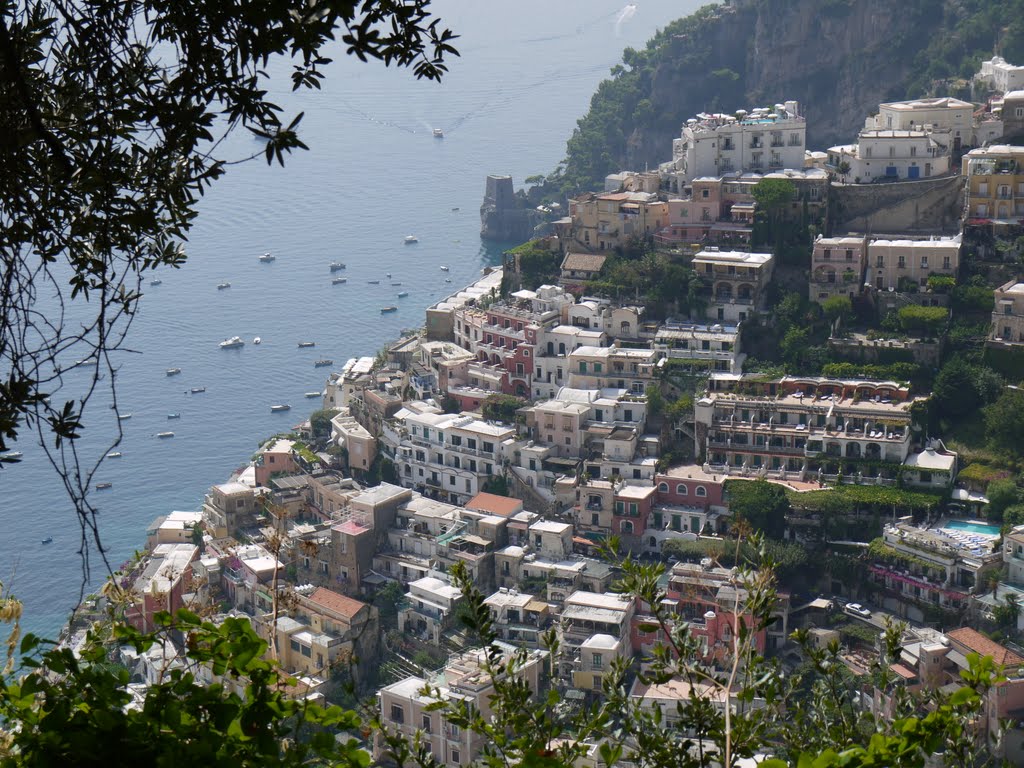Positano hotels, travel and tourist guide
Positano is situated in the Campania region of Italy, on the Amalfi Coast. Once a wealthy maritime power, it began the last century as a fishing settlement, and ended it as a popular, and rather chi-chi resort, famous for its hotels and boutiques as well as for the winding stairways that connect the town, and the towering cliffsabove. Every inch of land is prized; buildings are stacked up one above the other on the steep slopes, and open areas are intensively cultivated with fruit and vegetables thriving in the fertile volcanic soil.
The mountainous interior of the peninsula rises above the town, and Positano boasts one the world’s few ‘pierced’ mountains; a giant shoulder of rock with a hole punched through it (a miracle performed by the Virgin Mary, according to local folklore).
> Positano hotels and apartments
Positano history
Positano was once part of the powerful Republic of Amalfi, and played its part in international trading despite the lack of a harbour. Surviving Saracen raids, the town thrived and in the sixteenth and seventeenth centuries was famous for its trading with the East. Impressive palazzi were built; several are now romantically crumbling, others have been converted into luxury hotels. With the onset of the industrial revolution, harbourless Positano could not compete with rival ports, and had to wait until the birth of the tourist industry to regain its wealthy status.
Positano holiday information
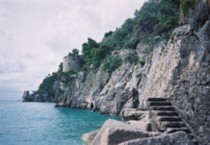
The holiday ‘season’ extends approximately from June to the end of September. The town is still alive and pleasant outside that period, although bus and ferry services could be reduced. If you want to avoid the crowds, October/November is a nice time to visit.
The atmosphere in Positano is cosmopolitan and international, while still feeling safe and restful. A kind of very exclusive village. Restaurants and shops (even general stores) tend to be expensive; it’s difficult to forget this is a resort aimed at the top end of the market. For many, of course, this adds to the appeal, and people-watching can be entertaining.
Things to see
If you’re bored of shopping, eating and relaxing, Positano has several churches of interest, most notably the Duomo by the beach, with its green and gold dome. The white-and-gold interior is airy and attractive and merits a visit, and the tiny piazza outside, where boys kick footballs around, is pure Italian.
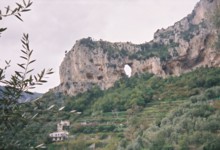
For a pleasant excursion, take the bus up to Montepertuso, where you can admire the hole in the mountain. Montepertuso is a sleepy village, lost in olive groves, which has a bar and a couple of restaurants. There are some good walks in the area, and many walking groups pass through Montepertuso, stopping for refreshments in the small piazza. The church has a spectacular setting, above the tiny houses of Positano, with the beautiful Galli Islands as a backdrop. To the right of the church is a path that will take you all the way back down to Positano. The walk takes about an hour and is surprisingly easy; if you don’t mind a lot of steps. Views are fantastic as you drop down towards the sea, through picturesque terraced olive groves and allotments.
Positano beaches
In a region where rocky cliffs descend straight to the water, Positano is unusual in that it has a couple of dark and gravelly beaches. Sections are cordoned-off stabilimenti, where you pay to use a sunbed, but parts are spiaggia libera, free beach, where anyone can put down their towels and enjoy the water. If you want a bit more peace than is afforded by the central beach, take the path above the water’s edge to the quieter bay at Fornillo (to the west, or your right as you face the sea).
![]() Positano Restaurant Experience
Positano Restaurant Experience
Lo Guarracino is an excellent and unpretentious eating place in a beautiful location. We enjoyed excellent pizzas and seafood on a terrace with gorgeous views over the sea. At night, instead of the view you can enjoy the sound of waves lapping.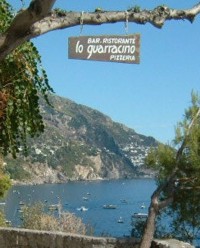
Positano food, drink and nightlife
There are few truly cheap options in Positano, but the choice for eating is wide and there should be something for everyone. Restaurants line the back of the beach; if the atmosphere is too noisy and touristy for you, try ascending the steps or roads to a quieter spot. Along Viale Pasitea there are a few nice places to eat, including the excellent Da Vincenzo. For absolute peace, and the sound of waves lapping against rocks, follow the path just above the sea towards Fornillo. A little way past the tower you’ll find Lo Guarracino, a restaurant on a terrace above the sea with excellent and affordable pizzas and seafood.
If you’re looking for somewhere to have a drink, at the end of the main beach is the prettily located Music on the Rocks, which is reputedly dressy and expensive. La Zagara tearoom (Via dei Mulini, 6) offers drinks and gorgeous desserts on a terrace, and has live music at night. Higher up on Viale Pasitea, you can sit at tables overlooking the water in a more peaceful environment, and hear live Neapolitan music.
Positano ballet
Positano is also known for its ballet associations. Diaghilev, impresario of Ballets Russes fame, Nijinsky, Massine (who owned the Galli Islands) and Stravinsky all spent time in Positano. Positano remained a popular destination for the ballet world, attracting famous guests such as Margot Fonteyn, Antony Tudor, John Cranko and Carla Fracci. Rudolf Nureyev bought one of the islands as a private retreat. For many years from 1969, the annual Massine ballet prizes were awarded in Positano every September. The tradition has been interrupted recently, so check if you are planning to visit. The awards ceremony on the first weekend of September, with performances by prize-winners, under the stars on the beach was a magical and unforgettable experience.
Positano travel information
Get to Positano
The Amalfi Coast page provides general travel information for Positano and other parts of the coastline. Positano is on the bus route between Amalfi and Sorrento (approximately an hour from Amalfi along the winding coast road, and half an hour from Sorrento). The blue SITA buses stop twice in Positano; the first stop from the Sorrento direction is at the junction of the coastal road with Viale Pasitea; the second is at the junction with Via Cristoforo Colombo. Buy your tickets at bars or newsstands before the bus arrives, and validate them in the machine provided onboard the bus.
Positano is also accessible by sea; an alternative option is to take a water taxi or ferry (although many will not run out of season).
Since most hotels are some way from the coastal road bus stops and the jetty, and roads/alleys are steep, you may find Positano Porter (tel: 0039 089 875 310, or ask your hotel) useful. A speedy porter service, they will transport your luggage around the town for you. Not cheap, but very handy.
Get around Positano
For transport within Positano there is a circular internal bus which is a handy option if you get tired of all the steps. This runs frequently (although traffic jams, funeral processions etc. can cause major delays in the narrow one-way streets). There is also a bus which runs up to the outlying villages of Montepertuso and Nocelle – this is approximately every 1-2 hours, and stops at Piazza dei Mulini and the junction of Viale Pasitea and the coast road. You don’t need a ticket in advance, you pay the driver.
Other excursions are possible by sea, from the small jetty by the main beach. There are kiosks where you can check details and make bookings; destinations include the Emerald Grotto (Grotto Smeraldo), the Galli Islands, Amalfi and Capri.

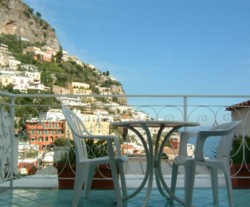
Positano hotels
See Italy Heaven’s selection of hotels in Positano, along with links for easy online booking, and our reviews of hotels we have stayed in.

On this site
Useful links
